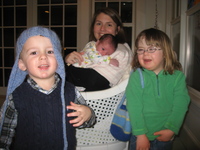I think of it this way…are you going to take better care of a family member that you love or a stranger that you are paid 8 hours a day to take care of? The secret of L’Arche is not just that the core members are at the core of the community but also the quality of relationship
that exists between core members and assistants.
Yet this relationship is also a covenant for a certain period of time in which we will be commit to the community and be faithful to God. For most assistants, this period is one to two years. For a founding community leader, it is much longer. When I agreed to serve in this
role as community leader for the next 6 years of my life, I realized that I am getting a much bigger family as happens in baptism. Just as in baptism we are given a gift and responsibility, so are those of us who come to L’Arche. We commit not just to a job but to each other. We are entrusted to the care of another.
Something happens when you eat meals with someone, pray with them, and celebrate their birthdays just as they celebrate yours. An openness to the other yields a real tenderness. You realize that neither of you would be who you are without the relationship you share that has formed you. An awareness of this mutuality, or unity in the Spirit, animates our life together.
When a brother or sister is hungry, you do not say go in peace and leave them without food. So also, when your brother or sister is crying out for touch, you do not bless them and depart. In L’Arche we are more than a group home because we know that to care for someone’s spirit, we must tend to the body. For those who have been neglected or abused, their cry is for human touch, safe touch that reveals to them that they are loved. When someone realizes that another wants to spend time with them and even delights in their presence, then the
spirit rises up and transformation occurs.
That we are a faith community necessarily means that we pray together. But the false assumption is that because we pray together, we might be a lesser group home. Precisely because we pray together, because we live out a covenant together, because we have become one body, that is why we care so much for bodies. Do we always do well? No. Is it
helpful to have external bodies that make sure we are doing it well? Yes! Of course, as you become family, you can become comfortable. Then it is easier to take your anger out on another unfairly. This is where being situated in a community is helpful. We can rely on others when we are unable, and we have a sense of accountability.
I suppose the heart of it all is that our mission is to reveal to the core members their gifts, that they are loved, that our lives are all the richer because we are in relationship with them. The mystery is how they reveal that to us all the more.

